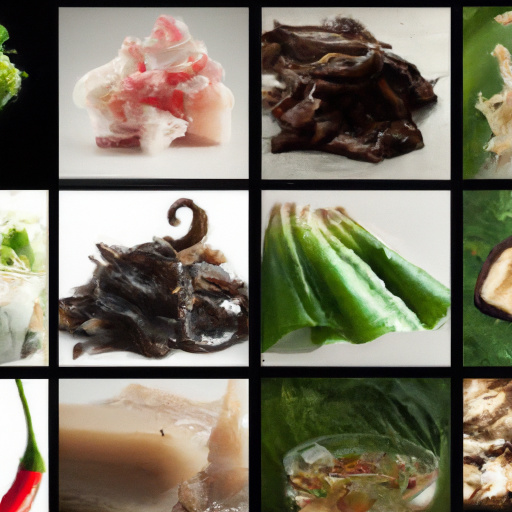The Magic of Umami: How to Use Japanese Ingredients to Elevate Your Cooking Game

Umami: The Magic Taste That Can Elevate Your Cooking Game
When we talk about taste, we usually refer to four basic sensations: sweet, sour, salty, and bitter. However, there is a fifth taste that can take your cooking to the next level – umami. The Japanese term for this flavor literally means "deliciousness" and refers to a savory, meaty, and brothy taste that enhances the complexity and roundness of a dish. In this article, we will explore the umami-rich ingredients from Japanese cuisine that can add depth of flavor and nutritional benefits to your cooking.
What Is Umami?
Umami was discovered in 1908 by a Japanese scientist named Kikunae Ikeda, who isolated glutamate from kelp and identified it as the source of the taste. Since then, umami has been recognized as a fundamental taste alongside sweet, sour, salty, and bitter. Glutamate is an amino acid that occurs naturally in many foods, particularly in protein-rich sources such as meat, fish, and cheese. When you cook these ingredients, they release free glutamate that binds with receptors on the tongue and the mouth, triggering the umami taste.
Umami-Rich Ingredients
Here are some of the umami-rich ingredients from Japanese cuisine that can help you enhance the flavor of your cooking:
Miso
Miso is a fermented paste made from soybeans, rice, barley, or other grains, and salt. It is commonly used in Japanese soups and stews, marinades, dressings, and dips. Miso contains high levels of glutamic acid, which gives it a rich, salty, and savory taste. There are several types of miso, ranging from light and sweet to dark and earthy, depending on the level of fermentation.
Dashi
Dashi is a broth or stock made from kombu (dried kelp) and bonito flakes (dried and smoked skipjack tuna). It is the base of many Japanese soups, sauces, and noodle dishes. Dashi has a delicate, yet complex flavor that combines umami, sweetness, and saltiness. It is also rich in nutrients such as iodine, calcium, and magnesium.
Nori
Nori is a type of seaweed that is often used to wrap sushi or as a topping for rice dishes. It is crisp, slightly salty, and has a subtle oceanic flavor that adds umami and texture to a dish. Nori is also a good source of vitamins A, C, and K, as well as iodine and iron.
Bonito Flakes
Bonito flakes, also known as katsuobushi, are thin shavings of dried, smoked, and fermented skipjack tuna. They are used as a seasoning in many Japanese dishes, particularly in dashi broth. Bonito flakes have a smoky, savory, and meaty taste that intensifies the umami flavor.
Soy Sauce
Soy sauce is a salty and savory condiment made from fermented soybeans, wheat, salt, and water. It is a staple of Japanese cuisine and is used as a seasoning for marinades, stir-fries, noodles, and sushi. Soy sauce contains a high amount of glutamates that contribute to its umami taste.
How to Use Umami-Rich Ingredients
Now that you know what umami is and which ingredients are rich in this flavor, it's time to incorporate them into your cooking. Here are some tips to help you use umami-rich ingredients effectively:
- Use miso in soups, dressings, and marinades to add depth of flavor and creaminess.
- Make dashi broth by simmering kombu and bonito flakes in water for 20-30 minutes, then strain it and use it in soups, stews, and sauces.
- Toast nori sheets and crumble them over rice, salads, or popcorn for an umami-rich crunch.
- Sprinkle bonito flakes on top of grilled vegetables, tofu, or eggs for a smoky, savory taste.
- Add soy sauce to stir-fries, noodles, and fried rice for a salty and savory note.
Conclusion
Umami is a taste sensation that can transform your cooking and make your dishes more delicious and nutritious. By using umami-rich ingredients from Japanese cuisine, such as miso, dashi, nori, bonito flakes, and soy sauce, you can add depth of flavor, complexity, and umami to your recipes. Experiment with these ingredients and see how they can elevate your cooking game to a whole new level.
Most Recent
- Unconventional and Delicious Ways to Use Quinoa in Your Cooking
- How to Perfectly Roast Cauliflower: Tips and Tricks for Maximum Flavor and Nutrition
- How to Make Creamy and Flavorful Hummus from Scratch: A Step-by-Step Guide
- How To Perfectly Crisp Bacon in the Oven: A Step-by-Step Guide for Flawless Results
- How To Properly Use and Care for Your Cast Iron Skillet: Tips and Techniques for Perfect Results Every Time

